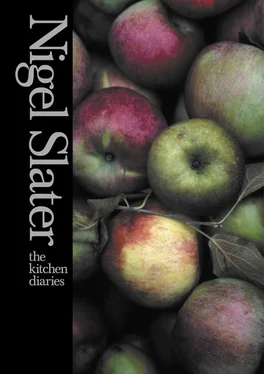A herb butter for grilled chops January 25 A herb butter for grilled chops I make a quick herb butter with equal amounts of blue cheese and butter (I use 100g of each), mashed with a tablespoon each of thyme leaves and Dijon mustard, then stir in a couple of tablespoons of double cream and a grinding of black pepper. It sits in the fridge till supper, when I lay thick slices of it on grilled pork steaks. The cheese butter melts over the charred edges of the chops, making an impromptu sauce to mop up with craggy lumps of sourdough bread. No matter how beautiful its carmine and orange stalks, the sight of a bunch of chard in my organic bag always makes my heart sink. This is unfair. It’s a useful vegetable, with lush, heavily veined green leaves and enough colour to liven up even the greyest of winter days. You can cook chard in a modicum of water, like spinach; it needs just enough to cover the stalks. I then drain it while the colours are still bright, say after six minutes or so, and drizzle it with olive oil, squeeze over masses of lemon juice and toss in a few green or black olives.
A pot-roast pheasant with celery and sage A pot-roast pheasant with celery and sage The pheasant’s lack of fat means that we need to find ways of keeping its flesh moist during cooking. The time-honoured way is to wrap the bird in fatty bacon. Fine. But I don’t always want the intrusion of that particular flavour. Another way is to let the pheasant cook in its own steam. In other words, a pot roast. What you get is plenty of juicy meat that tastes of itself and plenty of clear, savoury juices. a pheasant – plump and oven-ready butter – 2 thick slices (80g) garlic – 4 large, juicy cloves celery – 3 large stalks and a few leaves new potatoes – 12 smallish sage – 6 decent-sized leaves white vermouth such as Noilly Prat – 250ml Set the oven at 180°C/Gas 4. Wipe the pheasant and remove any stray feathers, then season it thoroughly with salt and pepper. Melt half the butter in a deep casserole, one to which you have a lid. You want it hot enough to brown the bird but not so hot that it burns too quickly. Put the bird in the hot butter, letting it colour heartily on all sides. When the skin is a rich gold, remove the bird, pour away the butter and wipe the pan with kitchen paper (the trick is to wipe away any burned butter but to leave any sticky goo stuck to the pan). Whilst the bird is colouring in the butter, you can peel the garlic, trim the celery and cut it into short (2cm) lengths, wash the potatoes and either halve them or slice them thickly, depending on their size. Melt the remaining butter in the pan and add the potatoes, letting them colour lightly. Then introduce the garlic, celery pieces and the sage and celery leaves and season with salt and pepper. Pour over the vermouth, bring to the boil, letting it bubble for a minute or two, then return the bird and any escaped juices to the pan. Cover with a lid and transfer to the oven for thirty-five to forty minutes. Remove the pan from the oven, take off the lid and gently split the bird's legs away from its body, nicking the skin with a knife as you go. Return the bird, legs akimbo and without the lid, to the oven for five minutes. Remove the legs, then remove each breast in one piece. Put a leg and a breast on each of two warm plates, then divide up the potatoes, celery and their juices. Enough for 2
A clear, hot mussel soup A clear, hot mussel soup The point is that this is a clean-tasting broth, hot and aromatic. If you wish to add fish sauce or even soy sauce, then do, but I suspect the recipe will lose its pure, simple flavours. The coriander is essential. mussels in their shells – 1kg light chicken or vegetable stock – 800ml a small, hot, red chilli the juice of 2 limes a little sea salt and sugar a handful of coriander leaves Scrub the mussels thoroughly, tug out any of the fibrous ‘beards’ that may be hanging from their shells and discard any that are broken or open. I always squeeze each mussel hard, pushing the shells together tightly to check they have some life in them. Any that refuse to close when squeezed or tapped on the side of the sink, or any that seem light for their size, should be discarded. Tip the mussels into a large, heavy pot over a high flame and add a splash of water. Cover them tightly with a lid and let them steam for a minute or two, till their shells are just open and the mussels are quivering and juicy. Remove them from the heat the second they are ready. Bring the stock to the boil. Cut the chilli in half, remove its seeds and chop the flesh very finely, then put it in with the stock, together with the lime juice, a pinch of salt and the same of sugar. Turn the stock down to a simmer. Remove the mussels from their cooking liquor, pull the flesh from the shells and drop it into the pan of stock, with a little of the mussel juices. Roughly chop the coriander leaves and stir them into the hot soup. Enough for 2
Sausages with salami and lentils Sausages with salami and lentils A rough-edged casserole that gives the impression of having been cooked for hours but is pretty much ready to eat in forty-five minutes. You could put it in the oven if you prefer, in which case you should let it cook for about an hour at moderate heat. This is the sort of food I like to put on the table at Saturday lunch, with a bowl of rocket salad by the side. Then you can swoosh the salad leaves around your plate to mop up the last bits of tomatoey lentil sauce. onions – 2 medium olive oil – 2 tablespoons garlic – 2 cloves a small salami – about 200g fresh sausages – 350g crushed tomatoes or tomato passata – 500g green or brown lentils – 150g bay leaves – 3 Peel the onions and cut each one in half from tip to root, then cut each half into four or five pieces. Warm the oil in a heavy-based casserole, add the onions and let them cook over a moderate heat until tender. Meanwhile, peel the garlic, slice it thinly and add it to the onions. You’ll need to stir them regularly. Peel the thin skin from the salami and cut the inside into fat matchsticks. Add this to the softening onions and leave for a couple of minutes, during which time the salami will darken slightly. Start cooking the sausages in a non-stick pan. You want them to colour on the outside; they will do most of their cooking once they are in the sauce. Tip the crushed tomatoes into the onions, add the washed lentils and stir in 500ml water. Bring to the boil. Remove the sausages from their pan and tuck them into the casserole with the bay leaves. Cover the pot with a lid and leave to simmer gently for about half an hour, until the lentils are tender. Stir the lentils and season with black pepper. You may find it needs little or no salt. Enough for 2, with seconds
A lime tart A lime tart Not difficult this, but do make absolutely certain there are no holes or cracks in the pastry case, otherwise the filling will escape, I guarantee. limes – 5–7 large eggs – 6 caster sugar – 250g double cream – 175ml For the pastry: plain flour – 175g golden icing sugar – 40g cold butter – 90g egg yolks – 2 cold water – 1 tablespoon To make the pastry, put the flour and icing sugar into a food processor, add the butter, cut into chunks, and blitz for a few seconds. Stop when the mixture resembles fine breadcrumbs. Mix in the egg yolks and water. Tip into a mixing bowl and bring the dough together into a thick log with your hands. Wrap it in greaseproof paper and refrigerate for a good half hour. Warning: skipping this bit will make your pastry shrink. Cut thin, round slices from the log of pastry, then press them into a loose-bottomed 23–24cm tart tin with high sides (3.5cm), pressing the pastry gently up the sides and over the base (this pastry is too fragile to roll). Make certain that there are absolutely no holes, otherwise the filling will leak through. Prick lightly with a fork and refrigerate for half an hour. Set the oven at 200°C/Gas 6. Place a sheet of greaseproof paper in the tart case and fill it with baking beans (I use old haricot beans but you can buy ceramic or metal beans especially for the job from cookware shops). Bake the tart case for ten minutes, then remove the greaseproof paper and beans and bake for a further five minutes, until the pastry is dry to the touch. Turn the oven down to 150°C/Gas 2. Finely grate the zest from two of the limes. Squeeze enough limes to give 180ml juice; this could be anything from five to seven limes, depending on their ripeness. Mix the eggs and sugar together, beating lightly for a few seconds – you don’t want it to be frothy – then stir in the lime juice and cream. Pour the mixture through a sieve and stir in the lime zest. Pour into the baked tart tin and bake for forty-five to fifty minutes. Remove whilst the filling is still a little wobbly and leave to cool. Enough for 8
Читать дальше












